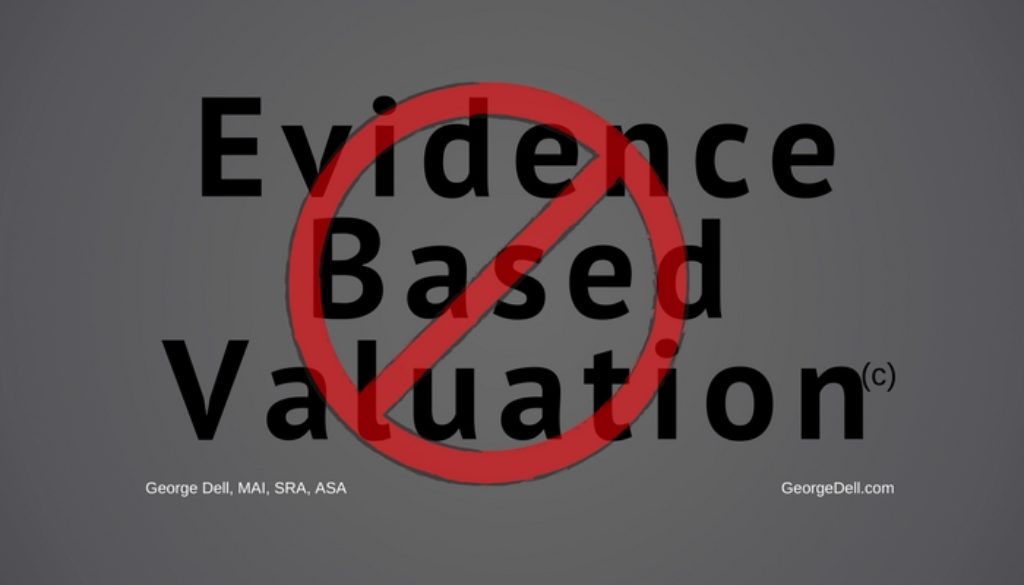I saw an article from the Washington Post, December 15, 2017, saying the administrative/enforcement branch of the U.S. government is banning the use of certain words or phrases. Two of the phrases include “science-based” and “evidence-based”.
As many of you know, I am an active advocate of Evidence Based Valuation.© If valuation based on evidence is so much better than that based on “good judgment,” why does it not dominate?
(This is an overview of the larger discussion, which will appear in Ann O’Rourke’s Appraisal Today paid newsletter for January, 2018).
If science-based valuation is so darn good, why is it just now becoming popular? There are many explanations:
- Personal resistance to change
- Organizational inertia
- Profession cultural norms
- Client expectations
- Regulatory edicts: license and banking
- USPAP
- Education
When it comes to change, appraisers have two strikes. First, we are of a “conservative” calling, supposed to be analytical, rather than expletive. Second, we’re human beings, automatically relying on the ‘tried and true’ as a steadier and easier way to do things. This is enhanced by the nature of our training. Most of what’s useful, we learn from our mentors and bosses – who in turn learned from their mentors and bosses. Then – across peers, this forms a culture of orthodoxy. Proposing change can bring unease, even fear, when old ways are challenged.
Cultural Norms
The cultural norms become formalized; in standards, regulations and client demands. The old, less productive way is enforced. It’s embedded in our literature, our education, our standards of practice, and government regulation. USPAP and our core education curriculum emphasize the “three approaches.” These are subjectively intermeshed and often “inbred” in the data. The three designated models are required in USPAP, when necessary for believability.
So we have two different ways of valuation. “Trust me” vs. “See my work.”
In traditional appraisal, the data selection is “judgment based,” with the overall test of acceptability being “credible” or “worthy of belief.” The process starts on a subjective basis, and concludes on a review – a personal judgment on believability.
In Evidence Based Valuation© the data set is analytically determined. The overall test is reproducibility. Modeling decisions are dramatically reduced, and usually obvious. Data inbreeding is analytically eliminated. The process starts on an objective basis, and concludes with a risk-scored, replicable analysis. The appraiser is judged not on judgment, but on the clarity of reproducible analysis.
Science Based Valuation© is not banned, but it’s sure not encouraged!

December 24, 2017 @ 4:08 pm
George, you left out the most obvious reason. Euphemism-Based valuation has simply failed to overcome it’s legitimate critics accurately identifying its shortcomings. Real Estate Appraisal is both an art and a science. Something the “Lets leverage Big Data” crowd refuse to acknowledge. The human ‘computer’ of the average appraiser in America today has acquired a ‘database’ of 55+- years nuanced life experiences. When that is wrapped around 30+- years of specific real estate sales and appraisal experience, I submit it is far more reliable than so called ‘science’ based systems that cannot reliably capture more than 70% of micro markets human participants actual perceptions. When Zillow; Trulia, RealTor.Com, RealAVM and all the rest start producing similar credible results on all the same properties, you be sure to let me know. In the interim, I’ll use that much more sophisticated neural network with all its human interfaces and their individual data bases for my local micro market knowledge. Regression and its ugly cousins are simply too unreliable and lack sufficient credibility. Argue it as as long as you wish, but systems that rely on complex formulae too sophisticated for most mere mortals to understand; and that fail to produce credible results ALL the time (it’s ‘science’ remember?) lost tranctions all on their own. You see George, those of us that cannot argue the math on the same plane as you don’t really have to. All we had to do is be able to read and remember the old fable The Emperor’s New Clothes.
December 24, 2017 @ 4:10 pm
traction
December 26, 2017 @ 9:29 am
Thanks Mike, straight from the horse’s , uh, “mouth” … ( how do you correctly spell “patootie”)
September 27, 2019 @ 12:50 pm
George – you’re my new hero. I am a business appraiser but all of this applied to our discipline. While I acknowledge that judgement is an important part of the appraisal process (otherwise, we would have been replaced by web sites by now), judgement must be informed, which I read to mean empirically founded. Plus, with new tools and data available, we can at least test to see whether areas of judgement are borne out by empirical data. On the BV side, too much of our professional is intellectually lazy and we don’t put in the effort to find, understand and distill empirical data that is out there and see if it contains intelligence that might benefit our client and the report’s intended audience.